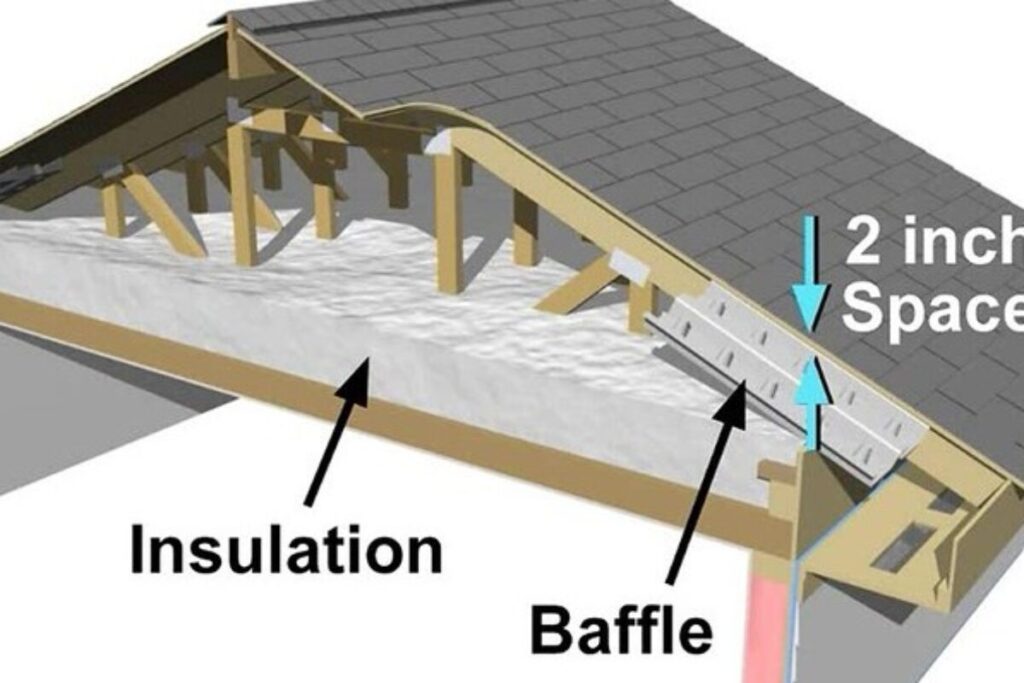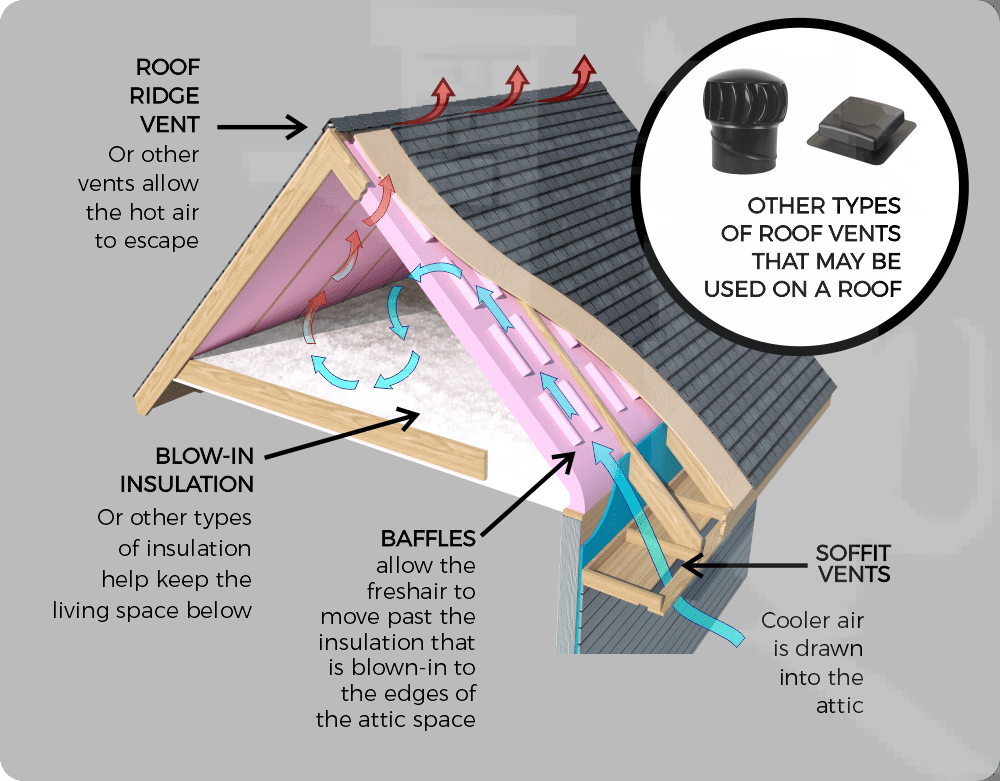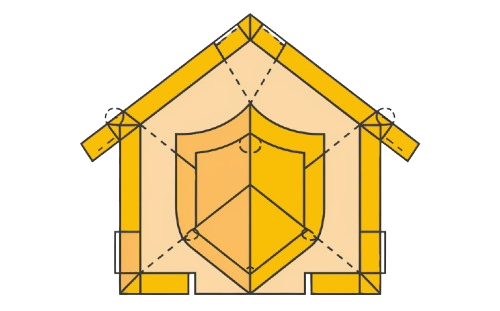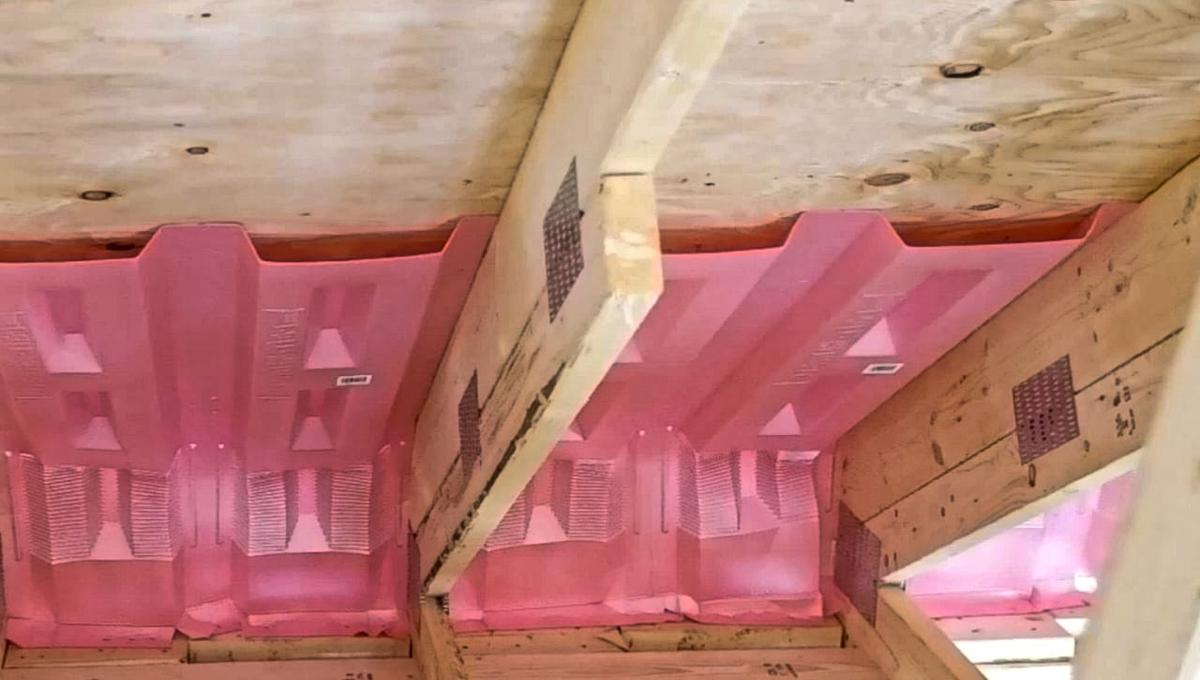When working on your attic insulation project, don’t overlook baffles—they are an essential component to ensure proper air circulation and preventing moisture buildup. These venting chutes act as a channel to guide air flow from your rafter vents and keep your insulation in top shape. Many homeowners think they can forgo installing attic baffles, but doing so risks mold growth and structural damage over time.
To install attic baffles properly, start by inspecting your attic. Check for specific areas where wind baffles or insulation baffles are needed, especially near venting chutes and rafter vents. Proper installation means placing a baffle in each space between rafters to maintain air flow and prevent blockage from insulation. This keeps moisture from accumulating, reducing issues like mold and protecting structural components from damage.
For a DIY project, choosing the right baffles is key to proper installation. While it might seem simple, checking below for both DIY tips and professional advice can help you avoid common issues and get better results.
What Are Attic Baffles?
Attic baffles are available in different materials like cardboard, foam, or PVC and play an important role in keeping your attic well-ventilated. They help circulate fresh air, prevent moisture buildup, and reduce the risk of insulation blocking soffit vents, which can impact airflow. This approach keeps your house more energy-efficient by stopping heat and cold air from getting trapped, preventing stagnant air, ice dams, or even damage to your roof deck over time.
When properly installed, baffles create a channel that allows air to flow freely from the outside through your roof vents, keeping your attic cooler in summer and warmer in winter. This helps to regulate temperature and reduce the risk of organic growth like mildew or mold inside your attic. Baffles are also important to prevent snow and ice from melting and freezing again, which can damage your roof structure.

You can buy baffles at hardware stores or home-improvement centers, and they come in various types to suit your needs. For DIY projects, cardboard and foam baffles are commonly chosen because they’re easy to install with staples. However, for rigid and more durable options, polyvinyl chloride (PVC) is a great choice, especially if you want something that can withstand temperature changes and last longer without getting weakened by moisture.
If you plan to construct a more well-insulated attic, using baffles in every section between rafters will help keep the airflow consistent and prevent any rolls of insulation from blocking the ventilation. This simple home-improvement project can go a long way in protecting your roof deck and interior from potential damage caused by freezes, melts, and organic buildup.
Benefits of Attic Baffles
Installing attic baffles comes with several benefits that help protect your home from common issues like moisture accumulation, mold growth, and structural damage. By allowing air circulation through your soffits and vents, baffles ensure a consistent airflow, reducing the risk of problems caused by improperly installed insulation or blocking.

Here are some of the important benefits of using attic baffles:
- Prevents condensation and mildew: During colder months, condensation can occur when warm air meets a cold roof deck. Baffles help prevent this by keeping air flowing and reducing moisture buildup, which can lead to musty smells and mold.
- Protects structural components: Ice dams can form when insulation blocks vents, causing water to back up under your roof deck. Proper baffle installation prevents this by keeping airflow steady and preventing ice from forming.
- Reduces temperature issues: In winter, baffles help maintain a good condition in your attic by preventing cold air from getting trapped. In the summer, they reduce heat buildup, making your home more energy-efficient and preventing damage to wood and other structural elements.
By keeping cavities between rafters clear and ensuring air circulation, attic baffles help maintain your insulation and protect your roof in all seasons, preventing both short-term issues and long-term damage.
Types of Attic Baffles
There are different types of baffles available, each designed to fit various areas in your attic and offer specific benefits. Choosing the best option depends on the materials, design, and the budget you’re working with. Here are the main types of baffles and their key features to help homeowners make the right choice:
- Styrofoam baffles: These are lightweight, affordable, and easy to install. They’re flexible and can be adjusted to fit soffit vents. Foam baffles are a practical option for those looking to reduce moisture buildup and mold growth. However, they may not withstand high pressure or cold weather as well as sturdier types.
- Cardboard baffles: Made from corrugated or foldable materials, these baffles are commonly used by homeowners because they are adaptable and can be easily folded to fit different heights and rafter parts. However, they tend to absorb moisture, which can lead to issues like mildew if not properly maintained.
- Plastic baffles: These are the most sturdy and durable types. Made from high-impact polystyrene (HIPS) or extruded materials, they can handle pressure from insulation and withstand harsh conditions. Plastic baffles are versatile, making them suitable for both hot and cold areas of the roof. They’re often seen as a long-term solution for preventing blocking and keeping air circulation consistent.
Whether you’re looking for lightweight foam, practical cardboard, or high-impact plastic baffles, it’s essential to determine which type will work best for your home.
How To Install Attic Baffles
Installing attic baffles is a crucial step to ensure your insulation works properly and prevents air leaks. Here’s a step-by-step guide to help you inspect your attic and install the baffles in the right way. Make sure you have the right gear like gloves, goggles, and a dust mask to protect your eyes and skin during the process.
- Inspect your attic and rafters: Start by inspecting the space between your rafters and the edges of your roof. If there’s old insulation, remove it from the bay areas where the baffles will go. Check for any rails or drywall that might block the installation process and take note of the points that need sealing.
- Install and secure the baffles: Place a baffle in each bay, making sure it fits snuggly between the rafters. The bottom of the baffle should start where the ceiling joist meets the roof rafters. Use a staple gun to attach the baffles to the sides of the rafters, ensuring they’re properly aligned and secured.
- Seal the edges to prevent air leaks: Once the baffles are in place, use spray foam to seal any connecting points and minimize gaps. This will help prevent air leaks and keep your attic well-insulated. After the baffles are installed, you can replace or add new insulation to complete the project.
Taking the time to properly install your attic baffles will improve the effectiveness of your insulation and prevent issues like irritation, hitting cold spots, and airflow problems.
A comprehensive installation process goes beyond placing baffles by including a blocker and air sealing at the exterior top plate seam. This approach offers several benefits that improve your home’s overall efficiency:
- Improved ventilation and airflow: Installing attic baffles creates an unobstructed channel for fresh air to move through the soffits and into your roof deck. This steady airflow helps regulate temperatures, preventing moisture buildup and reducing the chance of mold or insulation blockage.
- Prevents heat loss and protects your home: A thorough installation process includes air sealing at the top plate seam, which helps reduce issues like spilling insulation into soffits. This approach keeps your roof deck protected from temperature fluctuations and improves your home’s energy efficiency by minimizing heat loss in adjacent rooms.
- Enhanced comfort and fewer problems: Proper baffle installation ensures the blocker is in place, keeping your attic well-insulated. This not only protects your home but also makes rooms more comfortable by reducing drafts and moisture problems over time.
Should You Hire a Professional to Install Attic Baffles?
Installing attic baffles can be a DIY project, but there are times when hiring a professional contractor is a better choice. Contractors bring expertise and have the training to do a thorough job, ensuring the insulation and baffles are installed properly without missing key steps.
By choosing a qualified professional, you also get the benefit of insurance and licensing, which gives you peace of mind. Since this is often a full-time job for contractors, they can commit time to achieve better results and make sure your home stays safe and well-insulated.
Final Thoughts on Installing Attic Baffles
Installing attic baffles is a crucial step in maintaining proper attic ventilation and protecting your home from costly roof damage. These venting chutes improve airflow, reduce moisture buildup, and prevent insulation from blocking soffit vents. Whether you choose foam, cardboard, or plastic baffles, ensuring a proper installation process can protect your attic from issues like mold growth, ice dams, and structural damage. While it can be a DIY project, hiring a professional ensures better results. Ultimately, attic baffles help improve energy efficiency, protect your roof deck, and create a more comfortable living environment year-round.
Need help finding a trusted professional to install attic baffles in your home? Contact us today, and we’ll connect you with experienced experts who can ensure your attic is well-ventilated and protected year-round. Don’t let poor ventilation cause costly damage — take action now!
FAQ
How Should Baffles Be Installed?
When installing baffles in your attic, ensure each baffle fits snuggly in the space between rafters. The bottom of the baffle should start where the ceiling joist meets the roof. Make sure to cover the edges and keep them aligned to prevent any gaps in the insulation. Take care to adjust the baffles precisely for a secure fit and better airflow.
Do I Need Attic Baffles in Every Rafter?
Not every rafter in your attic needs baffles. Focus on areas with intake vents near the soffit to avoid blockage from insulation or debris. Check these spots carefully, but be prepared to squeeze into corners, as the process can be a bit cumbersome. Keep in mind that installing the right type of baffle ensures proper airflow.
How Far Up Should Attic Baffles Go?
When installing baffles in your attic, they don’t need to reach the ridgeline. For a traditional ceiling, the baffles should be taller than the insulation to prevent wind-washing. If you have a cathedral ceiling, the process is similar, but always remember to leave enough space for airflow to keep your attic well-ventilated.
Are Baffles Necessary for an Attic?
Yes, baffles play a crucial role in your attic by improving airflow and helping insulation work effectively. They prevent moisture buildup and keep your roof safe from damage. Often overlooked, baffles are the unsung heroes that ensure your attic system runs smoothly without any hiccups.

